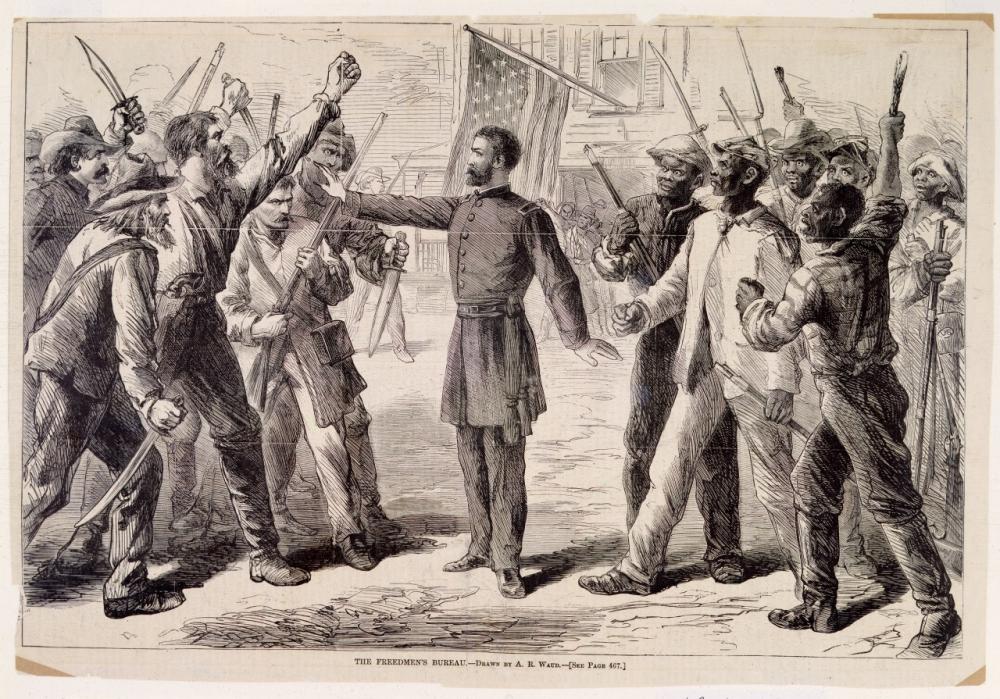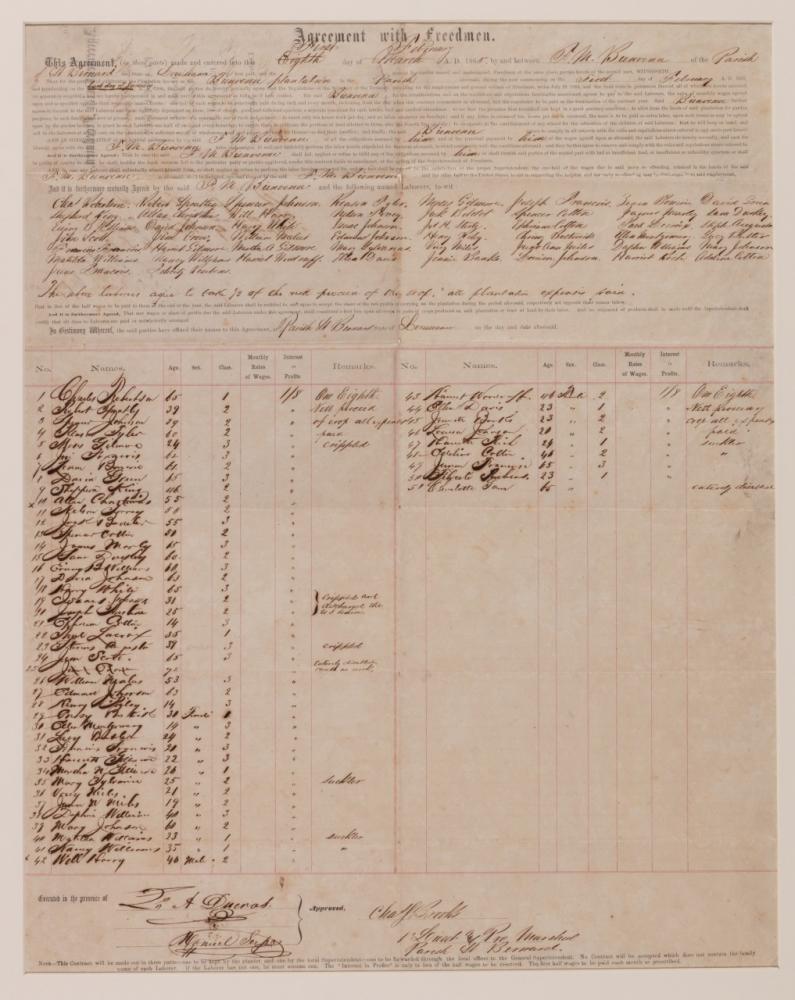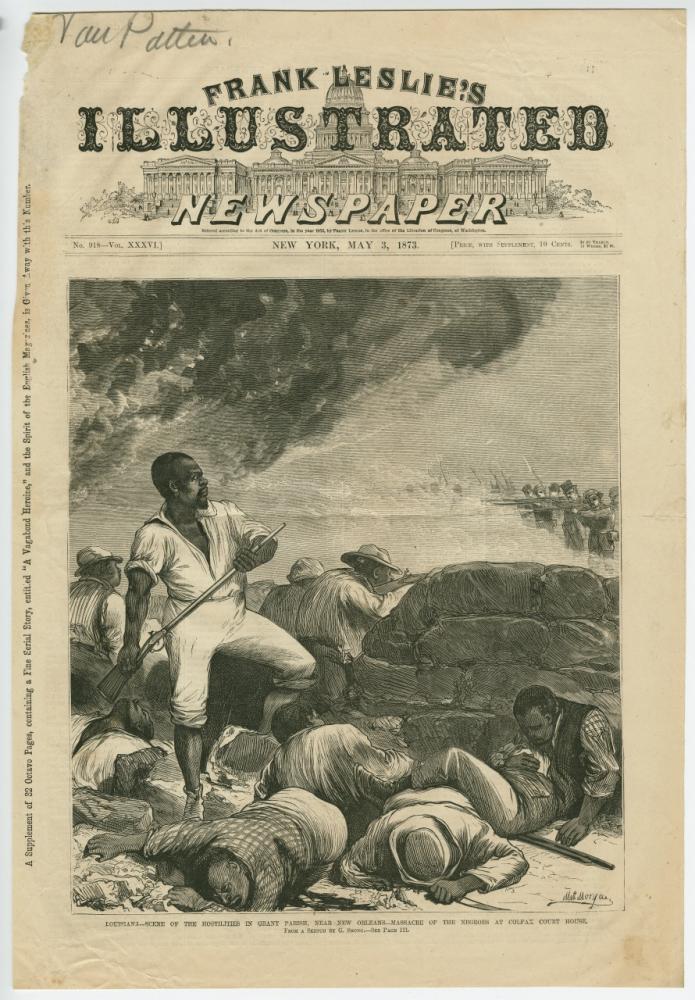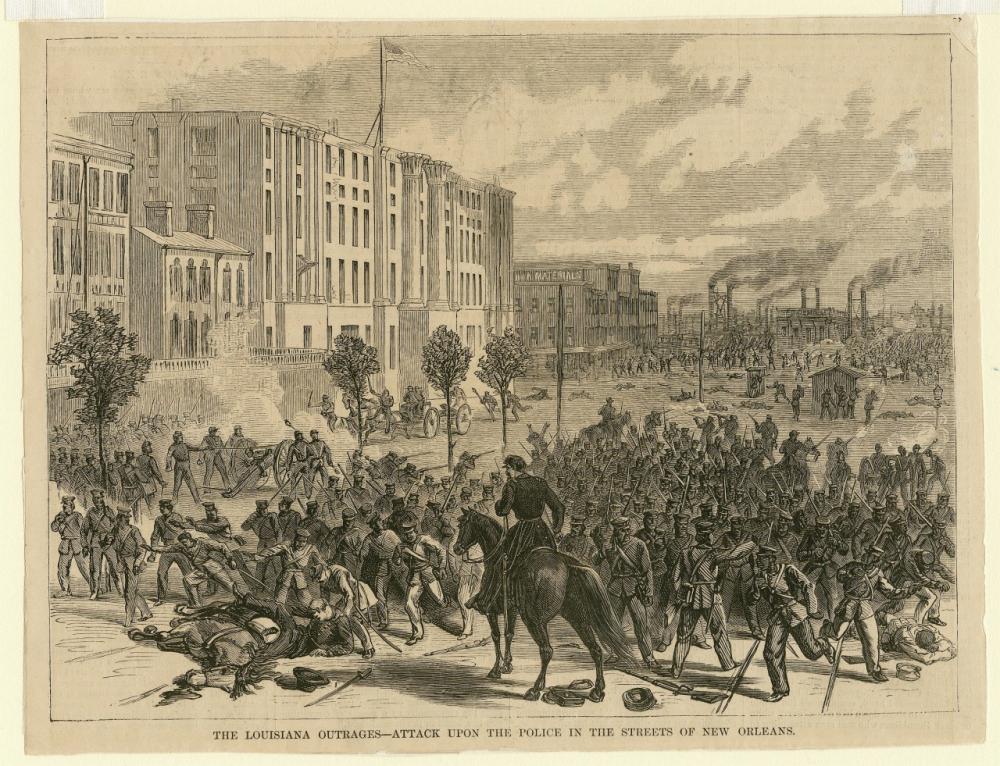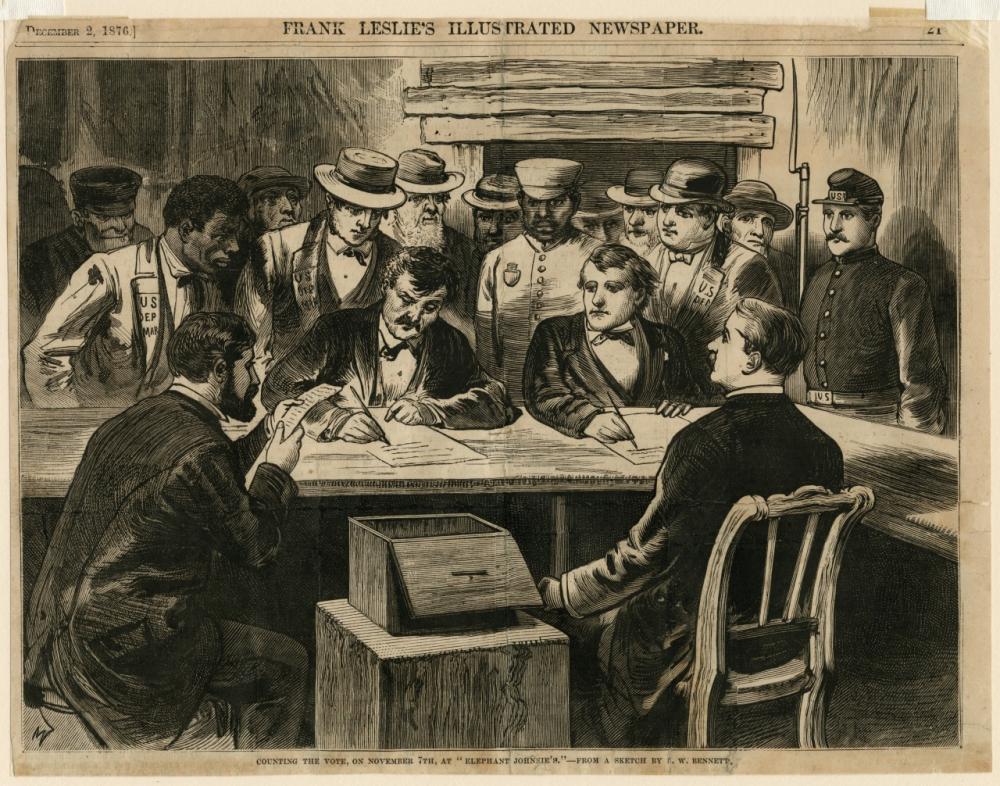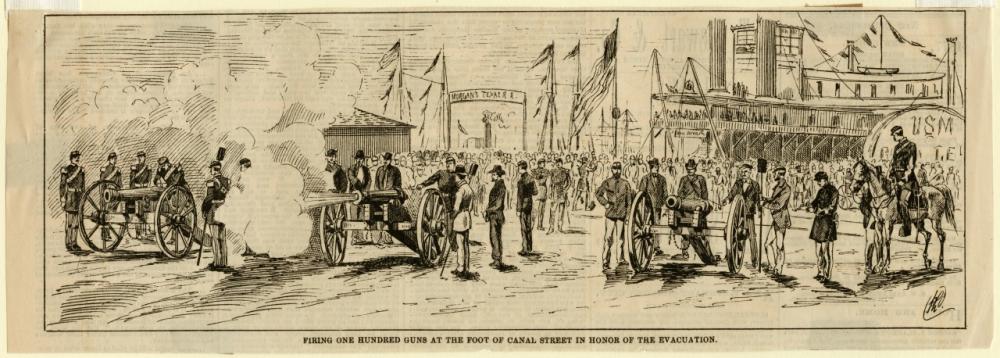Reconstruction was a time of change and unrest in the American South. This is particularly true for New Orleans. The city had been occupied near the start of the Civil War—in 1862—so the Reconstruction experience in New Orleans differed from that in other southern cities. New Orleans remained largely untouched and was renamed the capital of Louisiana in 1864. The Reconstruction era in New Orleans started around 1865—although some argue it started as early as 1862 when the city was first captured by Union troops—and lasted until 1877 when federal troops left the city. This was a time of great strides for African Americans, but also of great unrest. The following items from The Historic New Orleans Collection are emblematic of important moments during Reconstruction in New Orleans.
The seven items included below are a small selection of the materials in THNOC’s holdings related to Reconstruction in New Orleans.
The Freedmen’s Bureau
• Freedmen’s Bureaus were established in 1865 across the American South as a resource for newly freed slaves and poor whites who were unemployed and displaced. These organizations served as a clearinghouse for social services like food assistance and housing, offered assistance for medical and legal issues, and provided educational and vocational opportunities to communities of newly freed slaves.
• Freedmen’s Bureaus were operated and overseen by the federal government but suffered from a lack of funding and resources. They were established by an act of Congress and were originally intended to last until 1866—one year past the end of the Civil War. However, the services that these organizations provided were so badly needed by communities across the southern states that they continued to operate until the summer of 1868.
IMAGE CAPTION: The Freedmen’s Bureau; Alfred Rudolph Waud; Published in Harper’s Weekly on July 25, 1868; The Historic New Orleans Collection,1974.25.9.317
https://catalog.hnoc.org/web/arena/search#/entity/thnoc-archive/1956.50/panorama-of-the-seat-of-war3
F.M. Bienvenu Labor Agreement with Freedmen
• The Civil War changed the South’s economic system, which had been heavily reliant on agricultural slave labor. After slavery was abolished in 1865, the sharecropping system was created in response to the sudden influx of free and landless African Americans as well as impoverished white planters.
• Sharecropping started in the 1860s and lasted in some form until the 1950s. Sharecroppers worked the plantations and, in return, received a place to live, food, and a share of the cotton. Any wages earned were typically in the form of tokens redeemable only on-site at the plantation store. Plantation managers carefully controlled when sharecroppers could plant and harvest and could also deduct wages for additional services like plowing or ginning. This meant that sharecroppers received only between a quarter to a half the value of their crop. Often in bad crop years the sharecroppers would end up in debt.
• Initially, sharecroppers had control over their daily lives, but after the fall of Reconstruction, planters regained economic and political power and sharecroppers had less control and were subject to physical violence. While sharecropping did exchange services for goods, the land owners structured it to control the sharecroppers. Sharecroppers, like slaves, were carefully observed and managed by the land owners.
IMAGE CAPTION: F.M. Bienvenu Labor Agreement with Freedmen; February 1, 1865; signed by F.M. Bienvenu; The Historic New Orleans Collection, MSS 54.11
Click here for a transcription of this document
Extract from the Reconstructed Constitution of the State of Louisiana with Portraits of the Distinguished Members of the Convention and Assembly
 • At the behest of district military commander General Philip Henry Sheridan, a new Louisiana constitution was created in 1868. The new constitution provided African Americans with equal public accommodations, public education, and equal citizenship. This new constitution partially fulfilled the requirements for Louisiana’s remittance to the Union on June 25, 1868.
• At the behest of district military commander General Philip Henry Sheridan, a new Louisiana constitution was created in 1868. The new constitution provided African Americans with equal public accommodations, public education, and equal citizenship. This new constitution partially fulfilled the requirements for Louisiana’s remittance to the Union on June 25, 1868.
• The poster depicts 29 images of African Americans who were delegates to the Louisiana Constitutional Convention of 1868. In the center is a portrait of Oscar J. Dunn, who became Lieutenant Governor of Louisiana. P. B. S. Pinchback’s portrait is also centrally featured in the last row. When Dunn died in 1871, Pinchback assumed his duties as lieutenant governor. On December 8, 1872, Governor Henry Warmoth was impeached and removed from office, and Pinchback became the nation’s first African American governor. He served as governor for 36 days, from December 8, 1872 to January 18, 1873. During his short time as governor ten legislative bills were passed. William Pitt Kellogg was elected to the office of governor and Pinchback continued his political career.
IMAGE CAPTION: Extract from the Reconstructed Constitution of the State of Louisiana with Portraits of the Distinguished Members of the Convention and Assembly; Lithograph, 1868; The Historic New Orleans Collection, 1979.183
The Colfax Massacre
• The April 1873 Colfax Massacre was primarily sparked by tension between Republicans and Democrats over the 1872 governor’s election. On Easter Sunday a group of Democrats tried to take the courthouse in an effort to prevent Republican politicians from convening. These Democrats were against the expansion of civil rights and liberties that the Republican government favored. The Democratic aggressors allowed noncombatants to leave before setting the building on fire, but when defenders of the courthouse scattered, they were chased down and later executed. It was one of the bloodiest incidents during Reconstruction, resulting in the deaths of over 100 people, mostly African Americans.
• The Colfax Massacre led to United States v. Cruikshank, in which the Supreme Court ruled that the federal government had overstepped its bounds while attempting to prosecute some of the people responsible for the murders. The ruling undermined the Enforcement Acts of 1870, which were laws created to protect African Americans against white supremacist violence. It is because of this case that, by 1875, states became solely responsible for prosecuting racial and politically motivated crimes.
The Louisiana Outrages–Attack upon the police in the streets of New Orleans
• The Battle of Liberty Place occurred on September 14, 1874. This confrontation pitted supporters of the local Republican government and mayor William Pitt Kellogg against members of the White League. Before the hostilities even occurred, the White League used propaganda campaigns that targeted emotional and financial anxieties, which primed the city for support of their cause.
• The Battle of Liberty Place began on Canal Street, when White Leaguers clashed with members of the Metropolitan Police, an integrated federal police force. As the conflict escalated, White Leaguers gained the upper hand and even succeeded in overthrowing Kellogg and his government. Several days later, US President Grant sent in the National Guard to reinstate Kellogg as governor.
• Even though the White League’s victory was undone by this executive order, none of the White Leaguers were prosecuted for their actions.
IMAGE CAPTION: The Louisiana Outrages–Attack upon the police in the streets of New Orleans; Published in Harperis Weekly on October 3, 1874; The Historic New Orleans Collection, 1974.25.9.226
Counting the Vote, On November 7th, at “Elephant Johnnie’s”
• The results of the 1876 presidential election were widely disputed and eventually led to the end of Reconstruction. The election saw Republican nominee Rutherford B. Hayes oppose Democrat nominee Samuel J. Tilden. Tilden led the popular vote and had 184 out of the necessary 185 electoral votes, but the Republicans refused to accept this result. They accused Democrats of bribing, discouraging, and even threatening African American voters. Florida, Oregon, South Carolina, and Louisiana were four states with disputed results that barred either candidate from receiving the electoral majority. Each of these states submitted two different electoral returns to Congress.
• In January of 1877 Congress set up an electoral commission. The commission had 5 US representatives, 5 senators, and 5 Supreme Court justices. The commission voted eight to seven to grant Hayes the disputed electoral votes.
• Democrats were unsatisfied with these results and threated to keep Hayes out of office. This led to a meeting in February, where the Compromise of 1877 was created. In this compromise the Democrats agreed to accept Hayes’s election, and in return Republicans agreed to withdraw federal troops from the South, give financial aid to rebuilding the South, and name a prominent Southerner to Hayes’s cabinet. This image is unique because it depicts both white and African American voters after the collapse of Reconstruction in 1877.
IMAGE CAPTION: Counting the Vote, On November 7th, at “Elephant Johnnie’s”;
S.W. Bennett; Published in Frank Leslie’s Illustrated Newspaper on December 2, 1876; The Historic New Orleans Collection, 1959.27.19
Firing one hundred guns at the foot of Canal Street in honor of the evacuation
• This illustrates New Orleanians celebrating the withdrawal of federal troops from New Orleans on April 25, 1877. The compromise that prompted this withdrawal, commonly referred to as the “Corrupt Bargain,” effectively ended Reconstruction while also handing power back to the Democrats in the South.
• With the end of Reconstruction in 1877, African Americans across the South lost many of the rights they had gained during the postwar period. Once federal troops left the southern states, enforcement of civil rights legislation fell to local governments, which were often run by former Confederates or Confederate sympathizers.
IMAGE CAPTION: Firing one hundred guns at the foot of Canal Street in honor of the evacuation; May 2, 1877; The Historic New Orleans Collection, 1974.25.9.211

